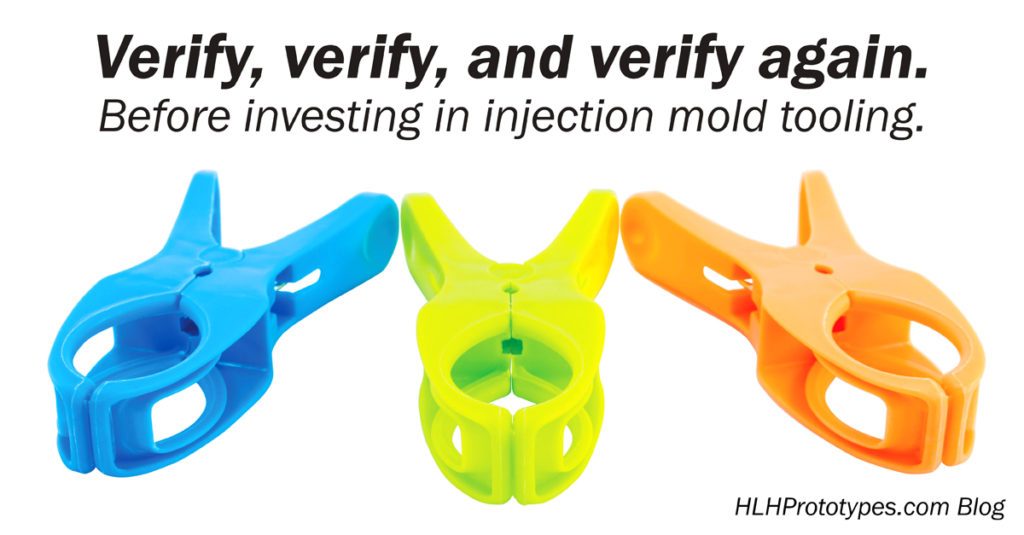Verify, verify, and verify to mitigate risk.

If you have a plastic part that has mass market appeal then your goal will be to use injection molding as your end manufacturing process. There is simply no manufacturing substitute for plastic parts when it comes to delivering a large number of parts fast and at the best possible per unit price. But injection molding does come with one caveat, upfront costs. All injection molding projects are upfront heavy, both in monetary costs and timeline costs. There is no avoiding it, there is only preparing for it.
The biggest potential cost with injection molding is the unknown cost. What happens if the market rejects your design? What happens if you make a huge error on your drawing? Well, the quick answer to both these questions is that you likely will have invested in the biggest paperweight in the world but now cannot afford a desk study enough to support it. Investing in injection mold tooling is a serious step and should not be rushed at the last minute. Verification of the design through prototyping and customer focus groups is vitally important before injection molding dollars are committed.
Mitigate Risk Through Prototyping – We need that first physical prototype in our hand to verify the basic design, to verify there are no obvious errors with the design. This first prototype can be a quick bare-bones version and can be fabricated from any rapid prototype technique. Once it is verified that there is no major issue with the geometry and basic function of the part it is time to move onto advanced prototyping for focus group testing.
Mitigate Risk Through Focus Groups – Here we take our advanced prototypes, as close to the finished article as we can get, and put it in front of people to get their reaction. A focus group does not have to be fancy, it does not have to be incredibly formal, the main goal is to let people test the product (ideally with some parameters as guidance) and see if their feedback aligns with what your internal expectations and data is telling you. A better way to test is to give the focus group several slightly different designs to see which features, feel or look they like best. You may also use this opportunity to test version 2.0 or 3.0 that you may have worked out but are not prepared to move forward with just yet. For these advanced prototypes, it is best to manufacture using a process like vacuum casting (urethane casting) as this process is a close mimic to injection molded parts. It is a lot cheaper at this stage to invest in some extra prototypes and get invaluable market feedback than it is to commit to an unverified injection mold design.
Mitigate Risk Through Low-Volume Manufacturing – If you have not completely verified your design through the first two steps above you can try low-volume production (for sale) of your product through manufacturing processes that do not require tooling, like 3D printing, CNC machining or vacuum casting. This will not work for all projects as many products need the per unit price advantages that injection molding offers to be able to hit market price points that are profitable. But testing out a low-volume manufacturing method (even if not completely profitable) can help you move forward on many other items like packaging and marketing while you are still trying to verify your final injection mold design.
Slowing down the injection molding process by using these risk mitigation steps will often save you time and money in the long run by eliminating mistakes via a carefully crafted verification process. Injection mold tooling is an expensive step, take the time to verify before you start.
Gary Moran
